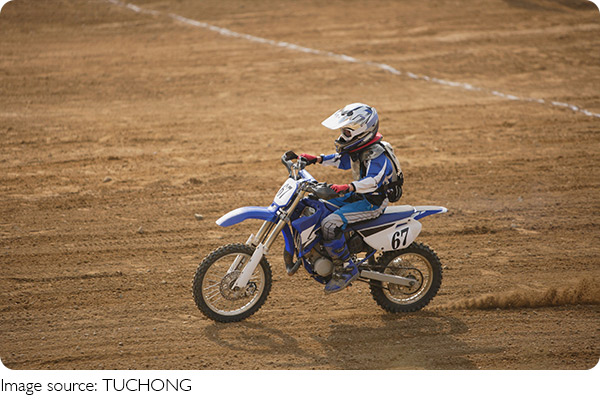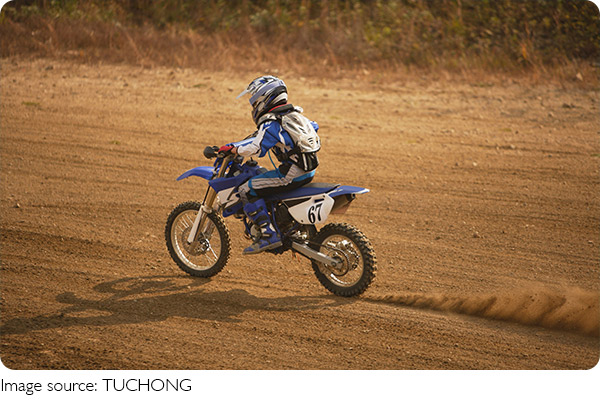Riding Tips

Motorcyclists have a saying: "Dress for the slide, not the ride." In other words, regardless of the weather conditions, every motorcyclist should wear proper protective gear to minimize injuries in case of a motorcycle collision.
The sense of wind and freedom is temporary, whereas life is concrete; therefore, prioritizing safety is paramount.
Riding a motorcycle is, in fact, a physically demanding activity, far from the comfort and ease it may seem on the surface. Especially during motorcycle trips, fully equipped riders may look cool, but only they know the discomfort of the gear they wear. It's common to see riders, particularly in hot weather or rain, wearing just a helmet or even a half-helmet, raising concerns about their safety.
1. Regarding protection for the upper body, options include one-piece leather suits, jackets, armor, etc. Among them, the most stylish and comprehensive in protection is undoubtedly the one-piece leather suit. A quality one-piece suit includes back armor, chest armor, elbow guards, knee guards, hip protectors, shoulder protectors, and hump, providing all-around protection.
It also combines functions such as wind resistance, insulation, and protection, all while being sleek, visually appealing, and well-fitting – a must-have for every motorcycle enthusiast.
A versatile riding jacket is a practical choice for most riders using motorcycles for a daily commute or for weekend trips. It offers warmth, wind resistance, waterproofing, multiple pockets, easy cleaning, and built-in protection, ensuring safety. Moreover, it can be worn as a regular jacket off the bike, making it more practical than a one-piece leather suit.
2. Your motorcycle helmet is the cornerstone of your riding gear. It is an essential item for any rider, regardless of the type of bike or speed. Choosing the fitting motorcycle helmet involves various factors, including maximum collision protection, wind resistance, and protection from road debris.
Remember that facial injuries are common in motorcycle accidents, so a full-face helmet provides the best protection. Full-face helmets may become hot and stuffy, so choosing one with excellent ventilation is crucial.
Helmets without facial protection leave the face exposed, and for these, adding a face shield is recommended to prevent debris or insects from entering the eyes or mouth. Modular helmets, which flip up in the front, provide a good compromise between three-quarters and full-face helmets.
Helmets should snugly fit your head without being too tight. Finding the right helmet size involves knowing your head circumference and shape. Read information on measuring your head for a motorcycle helmet and determining your head shape before trying on helmets.
3. Motorcycle gloves keep your hands comfortable, functional, and protected, with variations for all seasons and weather conditions. Leather gloves shield hands from blisters, wind, sun, and cold. In case of a fall, full-fingered gloves help prevent cuts and abrasions.
Gloves should fit snugly for better grip on the handlebars, allowing for proper motorcycle control. Seamless gloves or those with external seams help prevent blisters and pressure points. They also prevent cold air from entering the sleeves.
During motorcycle journeys, adhere to the following:
1. Ensure that the height of loaded items on the motorcycle does not exceed 1.5 meters from the ground and the length does not extend beyond the bike's body by 0.2 meters. For two-wheeled motorcycles, the width of loaded items on each side should not exceed 0.15 meters beyond the handlebars. For three-wheeled motorcycles, the width of packed items should not exceed the vehicle's body.
2. Adhere to the speed limits indicated by signs and road markings while riding a motorcycle. The speed limit on highways for motorcycles is 80 kilometers per hour. Avoid weaving in and out of traffic, and be cautious of illegal actions such as crossing lines, lane splitting, or riding against traffic, as these can have serious consequences.

3. Pay special attention to staying away from large turning vehicles, as they may have a "rear wheel offset" during turns, creating a blind spot in the driver's vision. Riding too close to turning vehicles or entering the blind spot can lead to accidents.
Life is fleeting, but keep riding on the road to one's dreams, even if it's nearing dusk. As long as there's breath, be a dream knight. Those who love motorcycles are forever young.

 · Vehicle Team
· Vehicle Team